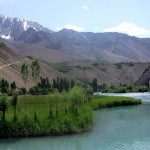Ever since the Indo-Pakistan war of 1947-8, Gilgit-Baltistan has been de facto administered by Pakistan. Known as the “Northern Areas” from 1970 to 2009, it was once part of the princely state of Jammu and Kashmir although much of its territory had been administered by the British under a lease as the Gilgit Agency from 1889 until 1947. The British regarded the area as being of vital strategic importance because it was where the British Empire bordered both China and Russian Central Asia. In 1947 the British cancelled the lease and handed the territory back to the Maharaja, but Gilgit troops under a British officer intervened to ensure that the area acceded to Pakistan.
Hitherto Pakistan has been careful not to integrate the territory and its neighbour ‘Azad Kashmir’ into Pakistan for fear of undermining its legal position on Kashmir before the United Nations. In India, Gilgit-Baltistan (at 73,000 sq km) and the much smaller Azad Kashmir (13,000 sq km) are collectively known as Pakistan Occupied Kashmir (POK).
No reasons for the committee’s decision have been made public, but there has been a recent push in Pakistan to tidy up some of its colonial era boundaries. On March 2, Pakistan announced that it was merging the Federally Administered Tribal Areas (FATA) on the Afghanistan border with the province of Khyber-Pakhtunkhwa (KP, formerly known as North West Frontier Province). Like the FATA, Gilgit-Baltistan has also suffered from a democratic deficit. For the 70 years of Pakistan’s existence the inhabitants have not enjoyed full representation and, with a majority Shia and Ismaili population, they have not always felt adequately represented in predominantly Sunni Pakistan. There is no clear evidence for a third possible reason: that China might have pressured Pakistan because of security concerns about the China Pakistan Economic Corridor (CPEC) which traverses the full length of Gilgit-Baltistan.
However, if the recommendation of the committee is adopted, it will signify a new calculation in Islamabad about the Kashmir dispute. Although both sides would formally deny it, the fact is that India has never seriously expected to ‘recover’ Gilgit-Baltistan from any Kashmir settlement. No more has Pakistan had any expectation of being awarded Jammu or Ladakh. In fact the whole Kashmir dispute can be (and has been) boiled down to three limited geographical areas: the Kashmir Valley, the Siachen Glacier and Sir Creek on the Arabian Sea. The outlines of agreements on Siachen and Sir Creek have been reached in the past and neither issue is a serious impediment to a wider agreement. The really thorny issue is the Kashmir Valley.
As early as 1950 the Australian High Court Judge, Sir Owen Dixon, the UN Representative for India and Pakistan appointed to mediate the Kashmir dispute, came to exactly the same conclusion. He proposed a plebiscite in the Kashmir Valley whilst awarding most other elements of the former princely state to the country in de facto control of territory. Under his “Dixon Plan” which came close to success, Gilgit-Baltistan would have become part of Pakistan, except that Nehru did not accept the conditions of the plebiscite.
More recently, Prime Minister Manmohan Singh’s long negotiation with President Musharraf from 2004 to 2008 resolved Siachen and Sir Creek and then focussed on the Kashmir Valley and the Line of Control (LoC). This negotiation also came close to agreement and only foundered due to Musharraf’s unconnected dispute with his Chief Justice. Whether either leader could have sold the solution to their more hawkish compatriots is a moot question. One of Musharraf’s generals later told this author that the Corps Commanders had been largely kept in the dark about the details. In his book, The Accidental Prime Minister, Singh’s media advisor Sanjaya Baru makes clear that some of the PM’s advisors were disconcerted by the scope of the discussions.
Nonetheless Manmohan Singh’s idea of treating the LoC as a ‘soft border’ with free movement and consultative mechanisms across both sides of it remains on the table–to be revisited when both India and Pakistan simultaneously have leaders strong enough to take the political risks innate in any such process.
What must be clear to Nawaz Sharif is that Kashmir will not be solved through a United Nations process, but through bilateral agreement.
Meanwhile, he and his new Army Chief Gen Qamar Javed Bajwa have to decide whether they can integrate Gilgit-Baltistan into Pakistan without setting off a major diplomatic storm. So far there have been protests from the UK Parliament and from Indian politicians, but otherwise, international reactions have been low-key. They may calculate, therefore, that now is the time to take a step which their predecessors have avoided for 70 years.
Tim Willasey-Wilsey is Senior Visiting Research Fellow at King’s College London, a former British diplomat and a member of the Chatham House Council.
This article was exclusively written for Gateway House: Indian Council on Global Relations. You can read more exclusive content here.
For interview requests with the author, or for permission to republish, please contact outreach@gatewayhouse.in.
© Copyright 2017 Gateway House: Indian Council on Global Relations. All rights reserved. Any unauthorized copying or reproduction is strictly prohibited
Bibliogrpahy
Durand, Algernon, The Making of a Frontier: Five Years’ Experience and Adventures in Gilgit, Hunza Nagar, Chitral, and the Eastern Hindu-Kush, Thomas Nelson & Sons, London, 1899, pp. 119.
“Discord in Pakistan’s Northern Areas”, International Crisis Group, no. 131, 2007.
Noorani, A. G., ‘The Dixon Plan’, Frontline, 19:21, October 2002, <http://www.frontline.in/static/html/fl1921/stories/20021025002508200.htm>
Lamb, Alastair, ‘Kashmir: A disputed legacy’, Oxford University Press, 1992.
James, Morrice, Pakistan Chronicle, Oxford University Press, London, 1993, pp. 83-104.
National Centre of Biography, Australian National University, Dixon, Sir Owen (1886-1972) by Grant Anderson & Daryl Dawson, Vol 14, Canberra, 1996.
Baru, Sanjaya, ‘The Accidental Prime Minister’, Penguin India, April 2014, pp. 178-197 & Kasuri, Khurshid Mahmud, ‘Neither a Hawk Nor a Dove: An Insider’s Account of Pakistan’s Foreign Relations’, Oxford University Press, December 2015.
‘Pakistan has to vacate PoK, Gilgit-Baltistan: India’, The Times of India, 23 March 2017, <http://timesofindia.indiatimes.com/india/pakistan-has-to-vacate-pok-gilgit-baltistan-india/articleshow/57794098.cms>


